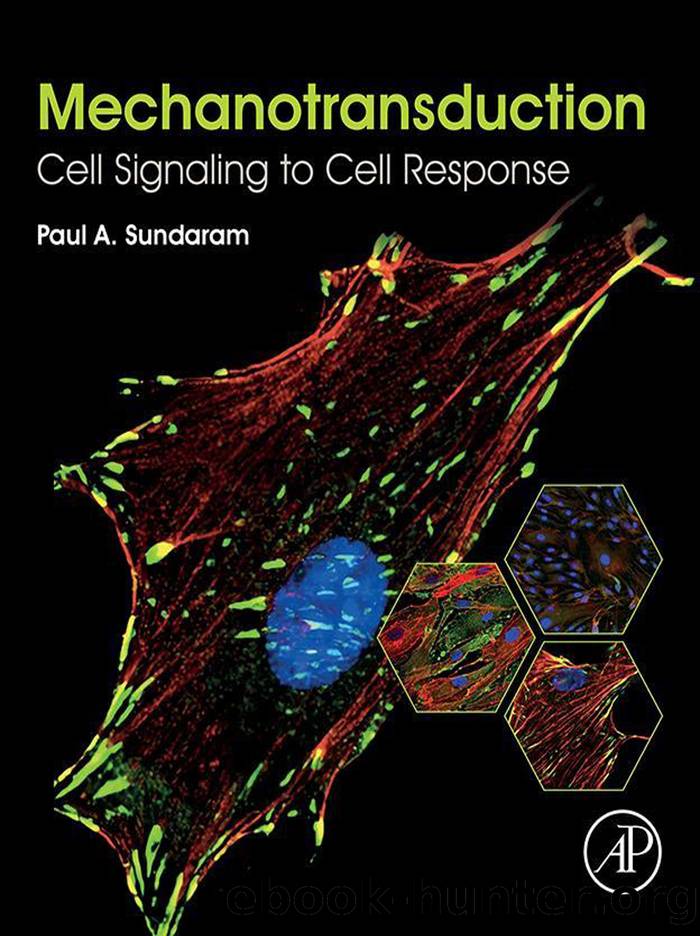Mechanotransduction by Sundaram Paul;

Author:Sundaram, Paul; [Sundaram, Paul A.]
Language: eng
Format: epub
Publisher: Elsevier Science & Technology
Published: 2021-04-15T00:00:00+00:00
4.3.3.2 Effect of stress magnitude
Some semblance of relative quantification has been ascertained with regard to the differentiation of human and mouse BMSCs under various types of mechanical stimuli. Low strain magnitude of less than 3% supports osteogenesis, whereas strains greater than 10% favor tenogenesis. The 10% strain stimulus upregulates the tenogenic genes Col I, Col III, and scleraxis, which is a tendon transcription factor. Application of cyclic strain at the 10% level increased Col I, Col III, and tenascin-C mRNA in rat BMSC culture, although at lower frequency, upregulation takes longer. It also appears that constant strain stimulus inhibits tenogenesis. It is hypothesized that myogenic differentiation of MSCs can be accomplished by mechanical stimulus in tension because this process is weak with the sole use of biochemical factors. Tension upregulates gene and protein expression, whereas neither Col mRNA nor ALP was detected in the MSC culture. A 10% tensile stretch at a 1 Hz frequency appears to be the optimal stimulus for cardiomyocyte gene upregulation. It must be noted that there are limits to the range of applied mechanical stimulus. Extremely low values of load or strain may not encourage proliferation, let alone enable stem cells to differentiate. On the other hand, highly intense stimuli may be detrimental to cell viability and result in apoptosis. Short spurts of applied stimuli are more beneficial in accomplishing stem cell differentiation than a sustained stimulus. Cyclic tensile loading is appropriate for the upregulation of early osteogenic markers and increases deposition of the mineralized phase. In addition, Col I mRNA and ALP activity are upregulated. Although the latter is observed solely under mechanical stimulation, dexamethasone medium was necessary for detecting early osteogenic markers such as osteopontin and osteocalcin. A strain magnitude of 10% in compression induced osteogenic genes in MSC, whereas both chondrogenic and osteogenic genes are induced by 15% compressive strain. Although the type of tissue formed is not clear, compressive mechanical stimulus gives rise to a nonfibrous cartilage-like tissue. There is a preconceived notion that because osteoblasts and osteocytes experience fluid flow stress in vivo, exposure of MSCs to fluid shear stress would lead to osteogenic differentiation. Although this appears to be true in experimental observations, fluid shear stress appears to have a stronger effect on matrix formation, which occurs at a later stage rather than the initiation of MSC differentiation to osteogenic tissue. Also, oscillatory fluid flow for short spurts appears to intensify matrix deposition.
Download
This site does not store any files on its server. We only index and link to content provided by other sites. Please contact the content providers to delete copyright contents if any and email us, we'll remove relevant links or contents immediately.
| Biochemistry | Biomedical Engineering |
| Biotechnology |
Whiskies Galore by Ian Buxton(41720)
Introduction to Aircraft Design (Cambridge Aerospace Series) by John P. Fielding(33017)
Small Unmanned Fixed-wing Aircraft Design by Andrew J. Keane Andras Sobester James P. Scanlan & András Sóbester & James P. Scanlan(32685)
Craft Beer for the Homebrewer by Michael Agnew(18082)
Turbulence by E. J. Noyes(7895)
The Complete Stick Figure Physics Tutorials by Allen Sarah(7265)
Kaplan MCAT General Chemistry Review by Kaplan(6823)
The Thirst by Nesbo Jo(6759)
Bad Blood by John Carreyrou(6477)
Modelling of Convective Heat and Mass Transfer in Rotating Flows by Igor V. Shevchuk(6354)
Learning SQL by Alan Beaulieu(6159)
Weapons of Math Destruction by Cathy O'Neil(6085)
Man-made Catastrophes and Risk Information Concealment by Dmitry Chernov & Didier Sornette(5878)
Digital Minimalism by Cal Newport;(5588)
Life 3.0: Being Human in the Age of Artificial Intelligence by Tegmark Max(5405)
iGen by Jean M. Twenge(5326)
Secrets of Antigravity Propulsion: Tesla, UFOs, and Classified Aerospace Technology by Ph.D. Paul A. Laviolette(5237)
Design of Trajectory Optimization Approach for Space Maneuver Vehicle Skip Entry Problems by Runqi Chai & Al Savvaris & Antonios Tsourdos & Senchun Chai(4957)
Electronic Devices & Circuits by Jacob Millman & Christos C. Halkias(4865)
